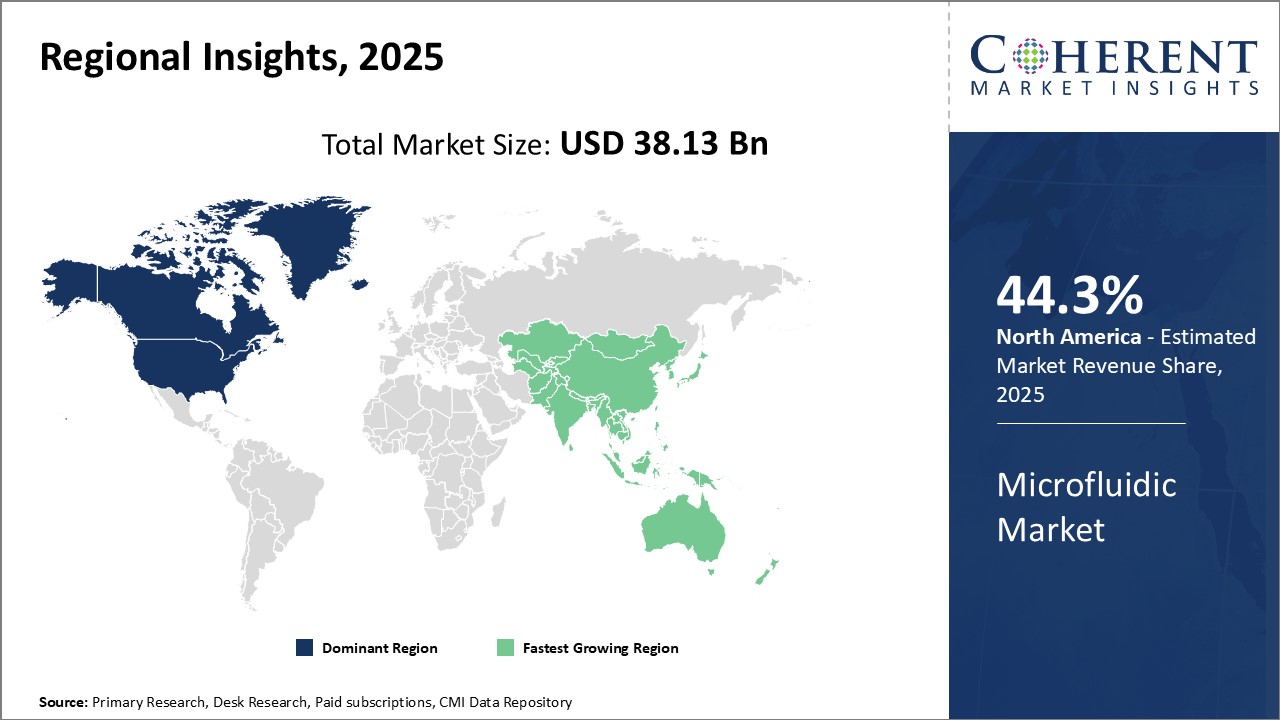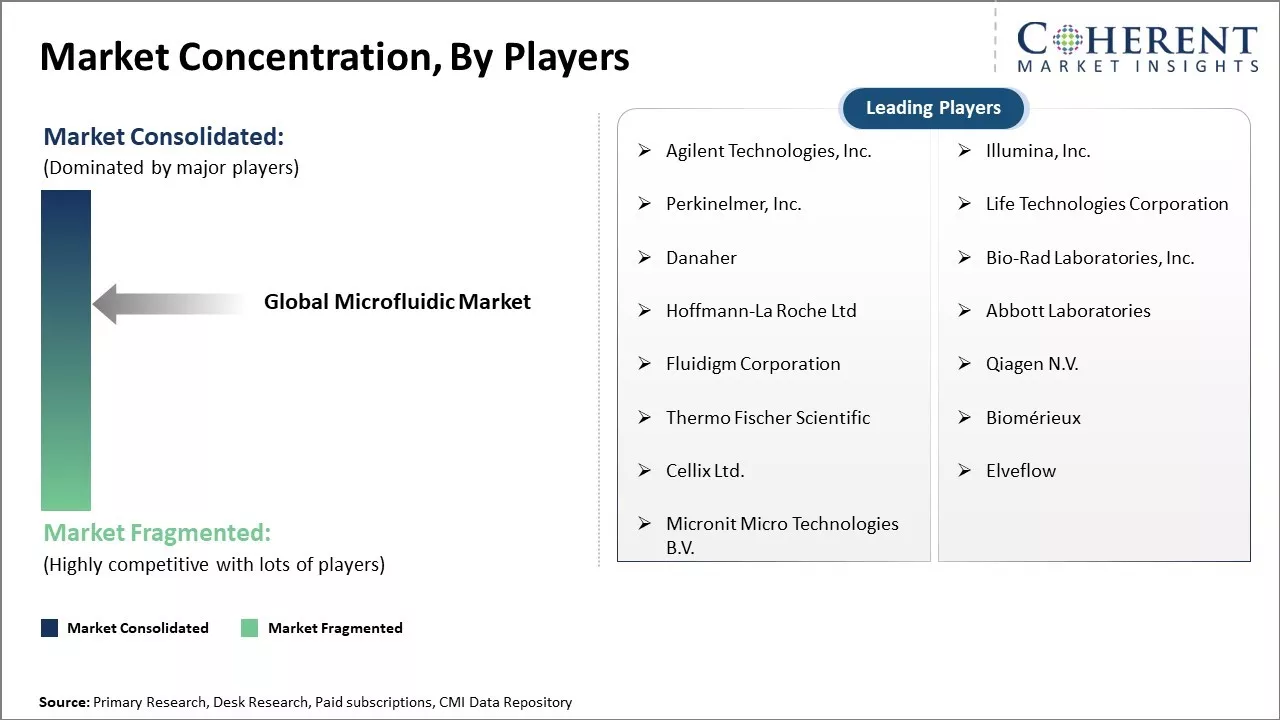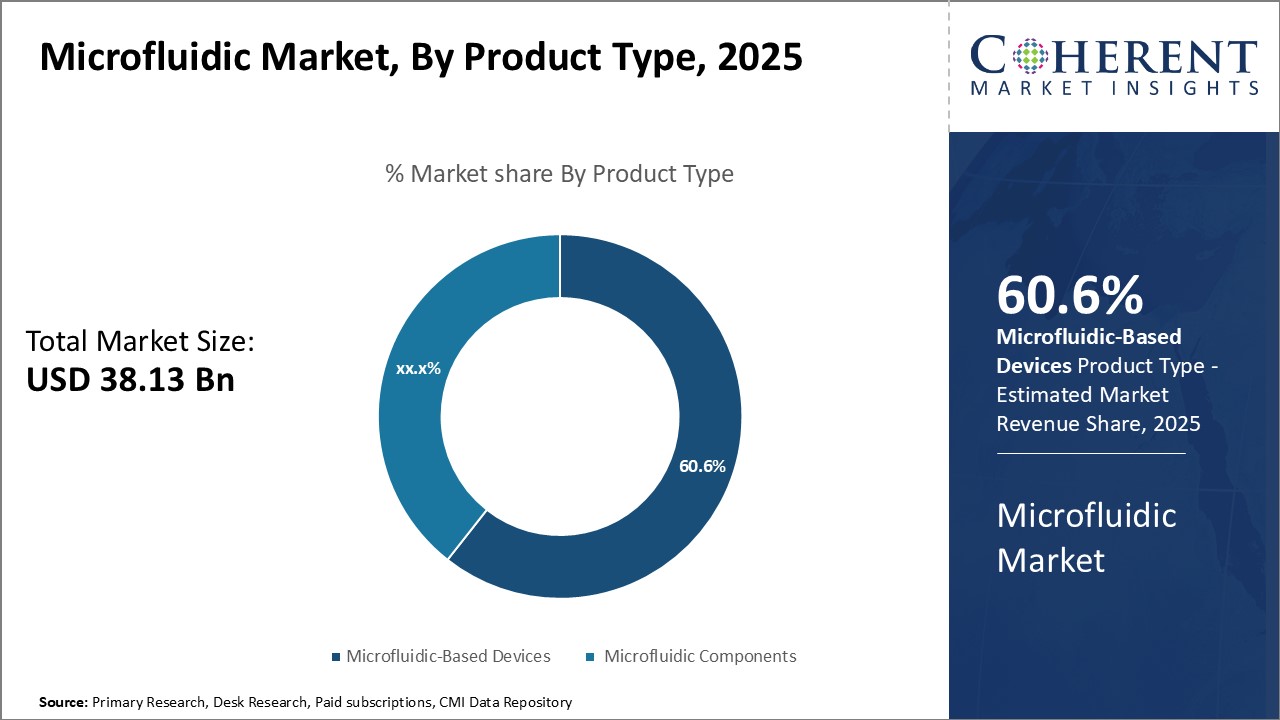Global microfluidic market is estimated to be valued at USD 38.13 Bn in 2025 and is expected to reach USD 102.74 Bn by 2032, exhibiting a compound annual growth rate (CAGR) of 15% from 2025 to 2032.

Discover market dynamics shaping the industry: Request sample copy
Rising demand for point-of-care testing and organ-on-chip technology in drug discovery can drive the market growth. Furthermore, increasing investments in research activities associated with microfluidics by public and private organizations can also drive the market growth. Various industries like in-vitro diagnostics, pharmaceutical and biotechnology are increasingly adopting microfluidic products and systems for improved precision, speaed and efficiency. The development of innovative application-specific microfluidic systems for fields including genomics and proteomics can offer new opportunities for market players in the near future.
Market Driver – Growing Demand for Point-of-Care Testing
Global microfluidic market growth is driven by increasing demand for point-of-care testing. Point-of-care testing allows diagnostic tests to be carried out nearer to the patient with quick results. This has been a boon especially for patients in remote locations who would otherwise have to travel long distances to a laboratory for regular testing. Microfluidic technology enables the miniaturization of laboratory functions on a single microchip, allowing complex chemical and biological diagnostic tests to be performed outside a laboratory setting. For example, microfluidic chips can now perform tests like glucose monitoring, immunoassays, DNA analysis from small and easily accessible samples like drops of blood via a fingerpick. This not only saves travel time and costs for patients but also provides real-time monitoring capabilities. Due to rising need for timely test results to make critical treatment decisions, there has been huge adoption of microfluidics for developing portable and handheld diagnostic tools near patients. Its ability to integrate multiple assay steps onto a single device while requiring minute sample volumes can attract researchers developing technologies like mobile health testing. For instance, according to the data published by Cancer Australia in 2023, 162,163 new cancer cases were diagnosed in Australia in 2022. This significant prevalence of cancer cases can boost demand for point-of-care diagnostics, thus, driving the market growth.

Get actionable strategies to beat competition: Request sample copy
Growing Focus on Lab-on-a-Chip Technologies
Increasing focus on developing advanced lab-on-a-chip technologies can also drive the market growth. Lab-on-a-chip refers to miniaturized devices that can replicate complex laboratory tests on a single microchip. By virtue of its ability to handle picolitre to nanolitre volumes of fluids, microfluidics provides an ideal platform for lab-on-a-chip development. Researchers are leveraging microfluidic techniques to design sophisticated chips mimicking microreactor, micropump, microvalve and micromixer functions of conventional analytical instruments on a compact footprint. This has led to the emergence of cutting-edge lab-on-a-chip systems capable of conducting advanced biomedical applications such as high-throughput screening, DNA sequencing, molecular diagnostics directly from minute native samples. Growing investments from governments and funding bodies to encourage lab-on-a-chip innovations enables the creation of highly integrated "labs" on a single microfluidic device. As more researchers realizing the potential of lab-on-a-chip to revolutionize fields like genetics, pharmacology and personalized medicine, microfluidics market can witness growth in the near future.
Key Takeaways from Analyst
Global microfluidic market growth is driven by increasing R&D investments in the healthcare sector. Areas such as disease diagnostics, drug discovery and precision medicine can boost demand for microfluidic technologies worldwide. North America dominates the market due to strong presence of leading players and growing funding for developing personalized therapeutics based on patient genetic profiles in the region. However, Asia Pacific is expected to emerge as the fastest growing market led by China as government support boosts healthcare infrastructure as well as investments in life sciences.
Decreasing device sizes and complexity of on-chip processes can offer new opportunities for microfluidic firms but high costs involved particularly in developing and manufacturing devices can hamper the market growth. Limited standardization across various application areas poses integration challenges restricting wider adoption. Rising preference for point-of-care and decentralized testing amid the ongoing pandemic can open new avenue for microfluidics in at-home diagnostics and telemedicine. Collaborations between players to combine microfluidics with other disciplines such as 3D printing can expand applications.
Market Challenges: High setup cost and relatively low production volume
The high setup costs associated with establishing microfluidic manufacturing and R&D facilities can hamper the global microfluidic market growth. Microfluidics is an interdisciplinary area that involves multiple domains such as engineering, physics, chemistry, and biology. Designing and manufacturing microfluidic chips and devices requires highly sophisticated equipment, cleanroom facilities, and skilled workforce that can handle miniaturized fluid flows. This makes the initial capital expenditure required to enter the microfluidic industry quite substantial. For emerging or smaller companies, the high setup costs present a formidable barrier to entering the market. Additionally, because demand and applications for microfluidics are still developing, production volumes remain modest in relation to the expenses involved. This limits the ability of companies to achieve substantial economies of scale that could reduce product costs and enhance profitability. With low production volumes, companies find it difficult to recover the high initial setup investments over time. This uncertainty over business viability and high barrier to entry deters new players from investing in microfluidic technologies. Even larger corporations and research institutes hesitate before dedicating heavy resources towards microfluidics.
Market Opportunities: Growing applications in in-vitro diagnostics, genomics, and proteomics
The expanding applications of microfluidics in areas of in-vitro diagnostics, genomics and proteomics can offer opportunity for the global microfluidic market growth. Microfluidic technologies are revolutionizing the field of molecular diagnostics by enabling lab-on-a-chip devices that can analyze biological samples with high sensitivity, specificity and speed. This helps in convenient and affordable point-of-care testing outside centralized laboratories. For example, microfluidic-based COVID-19 tests developed by authorities in the U.K. and Singapore last year allowed results within 30-45 minutes with a high degree of accuracy compared to traditional tests.
As genomic and proteomic research continues to gather pace, microfluidics plays a pivotal role by miniaturizing sequencing and sample analysis workflows. Several microfluidic-based genomic and proteomic assays have been commercialized in recent times, facilitating high-throughput analysis of DNA, RNA and proteins. For example, microfluidic western blot chips developed by the University of Toronto allow automated protein analysis from minute biofluid samples within 1-2 hours instead of the conventional process taking over 24 hours. This has immense potential in accelerating biomarker discovery, personalized medicine and disease diagnostics. Technological advancements can expand microfluidics usage in diverse areas including pharmacokinetic studies, drug discovery, biomanufacturing and pathology. WHO estimated that microfluidic-based liquid biopsies analyzing blood or urine samples could revolutionize non-invasive cancer screening approach over the next decade.

Discover high revenue pocket segments and roadmap to it: Request sample copy
By Product Type - Advancements in Microfluidic Device Design Drives Segment Growth
In terms of product type, microfluidic-based devices segment is estimated to contribute the highest market share of 60.6% in 2025, owing to continuous innovation and improvements in device architecture. Microfluidic devices have become highly sophisticated over the past decade allowing for more complex assays and analyses to be conducted on extremely small fluid volumes. Major players in the space are investing heavily in R&D to develop novel device designs with enhanced functionalities. For example, devices with integrated optics, fluid handling and control capabilities are becoming more mainstream, facilitating applications such as high-throughput screening and point-of-care testing. Miniaturization of devices can also boost demand. Researchers are designing microfluidic chips that can perform multiple tests in parallel on a single sample, improving productivity and efficiency. Portable and handheld device formats are also gaining traction as these enable near-patient and field testing. This shift towards portable formats that mimic traditional laboratory techniques but with a microfluidic approach. The increased functionality and portability of newer generation microfluidic devices can boost adoption across various applications in healthcare, biotechnology and pharmaceutical industries.
By Material - Wide Material Compatibility and Versatility of Polymers
In terms of material, polymer segment is estimated to contribute the highest market share of 40.6% in 2025, owing to its versatile properties and wide compatibility with device fabrication techniques. Polymers such as PDMS, PMMA and thermoplastics offer key advantages over other materials for microfluidic device construction. These are optically transparent, biocompatible, gas permeable, and can be easily molded into complex 3D channel architectures using soft lithography or injection molding methods. This is a major facilitator for rapid device prototyping and manufacturing. Polymers also allow for low-cost, high-volume fabrication of devices. Mass production of polymer devices through replication molding helps reduce per unit costs significantly, opening up the technology for real-world, commercial applications. Another advantage of polymer is their ability to be modified chemically or with surface treatments to attain desired surface properties essential for particular assays. Bonding of fluidic components constructed from different polymers enables multi-layered device architecture for complex analysis. Their material properties provide flexibility during microfluidic chip designing.
By Application -Point of care Testing Dominates Due to Need for Real-Time Diagnostics
In terms of application, point of care testing segment is estimated to contribute the highest market share of 20.6% in 2025, due to growing need for portable, near-patient diagnostic solutions that can rapidly detect diseases. The declining accessibility to central laboratory facilities in developing regions has boosted demand for self-contained, affordable point-of-care testing devices that deliver lab-quality results outside of traditional facilities. Increasing incidence of infectious diseases and chronic illnesses such as diabetes also necessitates continuous health monitoring solutions. Microfluidic-based point-of-care devices have proven effective in automating disease detection from small sample volumes such as finger-prick blood samples within minutes. This enables real-time diagnostic decisions and expedited clinical treatment. The ease of use of microfluidic lateral flow assay-based point-of-care platforms has found applications in resource-limited settings as well. Portability and self-contained formats simplify testing procedures for use even by semi-skilled personnel. These eliminate the need for complex, expensive laboratory infrastructure and trained technicians. This facilitates access to timely diagnostics almost anywhere, driving the utility and adoption of microfluidic point-of-care technologies across infectious disease control programs and clinics worldwide.

Need a Different Region or Segment? Customize now
North America dominates the global microfluidic market, with an estimated market share of 44.3% in 2025, due to strong presence of key players in countries like the U.S. and Canada. The U.S., in particular, is home to some of the top microfluidic companies and research institutes that are continually pushing the boundaries of microfluidics technology. The region also has a highly advanced healthcare infrastructure and growing biotechnology industry that boosts demand for microfluidic-based diagnostics, devices and other products.
The presence of a strong funding environment for microfluidics research through government organizations like the National Institutes of Health has encouraged innovation. Furthermore, presence of top tier universities and research centers engaged in microfluidics development drives the regional market growth. Major companies in the region also actively collaborate with academia, and this boosts commercialization of new microfluidic applications. Rising focus on development of personalized medicine solutions can drive the market growth.
Asia Pacific region has emerged as the fastest growing market for microfluidics. In particular, countries like China and India are indicating promising growth due to heavy investments by both public and private players to develop local microfluidics manufacturing capabilities and expertise. Both nations recognize microfluidics as an important technology for the future and have introduced various initiatives to encourage research. The availability of low-cost manufacturing infrastructure and skilled workforce provides region an competitive advantage in microfluidics mass production.
Microfluidic Market Report Coverage
| Report Coverage | Details | ||
|---|---|---|---|
| Base Year: | 2024 | Market Size in 2025: | USD 38.13 Bn |
| Historical Data for: | 2020 To 2024 | Forecast Period: | 2025 To 2032 |
| Forecast Period 2025 to 2032 CAGR: | 15.2% | 2032 Value Projection: | USD 102.74 Bn |
| Geographies covered: |
|
||
| Segments covered: |
|
||
| Companies covered: |
Agilent Technologies, Inc., Illumina, Inc., Perkinelmer, Inc., Life Technologies Corporation, Danaher, Bio-Rad Laboratories, Inc., Hoffmann-La Roche Ltd, Abbott Laboratories, Fluidigm Corporation, Qiagen N.V., Thermo Fischer Scientific, Biomérieux, Cellix Ltd., Elveflow, Micronit Micro Technologies B.V. |
||
| Growth Drivers: |
|
||
| Restraints & Challenges: |
|
||
Uncover macros and micros vetted on 75+ parameters: Get instant access to report
*Definition: Global Microfluidic Market involves products and technologies that deal with the behavior, precise control and manipulation of fluids that are geometrically constrained to a small, typically sub-millimeter, scale at which capillary penetration governs mass transport. It includes microfluidic chips, microfluidic components such as micropumps, microneedles and microfabricated sensors as well as other lab-on-a-chip devices. It has wide applications in fields like healthcare diagnostics, drug delivery and discovery, proteomics, micro-reactor technology and biosensing. The market growth is driven by technological advancements and rising demand from various industries.
Share
Share
About Author
Manisha Vibhute is a consultant with over 5 years of experience in market research and consulting. With a strong understanding of market dynamics, Manisha assists clients in developing effective market access strategies. She helps medical device companies navigate pricing, reimbursement, and regulatory pathways to ensure successful product launches.
Missing comfort of reading report in your local language? Find your preferred language :
Transform your Strategy with Exclusive Trending Reports :
Frequently Asked Questions
Joining thousands of companies around the world committed to making the Excellent Business Solutions.
View All Our Clients
US Reciprocal Tax Impact Analysis On Microfluidic Market
Stay updated on tariff changes with expert insights and timely information